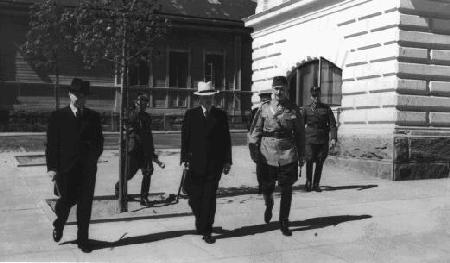


The proclamation was a source of inspiration to the friends of tribal ideals. A delegation from Joensuu and Sortavala managed to persuade both the Senate and the Commander-in-Chief to support their plan of sending out an expedition to liberate White Karelia. Mannerheim even went a step further and extended the plan to concern the Aunus district as well.
On the other hand, the proclamation aroused criticism, concerning resources, which were considered insufficient, and the timing, which was thought to be inappopriate. The question of Eastern Karelia would be a political subject of dispute before the Finns would even have any real influence in the area.
At the initial stages of the Continuation War, when an offensive of the Karelian army towards Lake Ladoga and the River Syväri was being prepared, Mannerheim issued the Order of the Day number 4 of the Commander-in-Chief, in which he referred to his promise of 1918, to expel the Bolsheviks out of Russian Karelia, to liberate the Karelian nations and to accord to Finland a great future. He said that the Karelians’ own battallions were marching in the ranks of the Finnish army, which was a reference to the so-called tribal battallions assembled in Finland.
In Mannerheim’s view, his proclamation was in accordance with the ideas of the administration of the state, reflecting even a wider public opinion. This sort of an Order of the Day, in which aspirations for territorial expansion, for Great Finland, could be read in between the lines, aroused attention – negative as well as positive – among the political circles both in Finland and elsewhere in the world. The government, who found the proclamation too outspoken, tried to soften the tone by diplomatic means, although they never actually renounced its basic message.
World War II | Pacific War | Winter War | Headquarters | Mannerheim Line | Vilho Petter Nenonen | K.L. Oesch | Harald Öhquist | Paavo Talvela | Continuation War |Transit Pact | Risto Ryti | Order of the Day of the Sword Scabbard | Erik Heinrichs | A.F. Airo | Hugo Österman | Marshal's Drink | Mannerheim Cross | Title of Marshal of Finland | Air War - Air Forces
COURSE OF LIFE | FAMILY | TIME OF GROWTH | MILITARY CAREER | WAR OF INDEPENDENCE | REGENT 1918-1919 | CIVILIAN | DEFENCE COUNCIL | COMMANDER-IN-CHIEF 1939-1946 | PRESIDENT OF THE REPUBLIC 1944-1946 | RETIREMENT | SPECIAL TOPICS | SEARCH